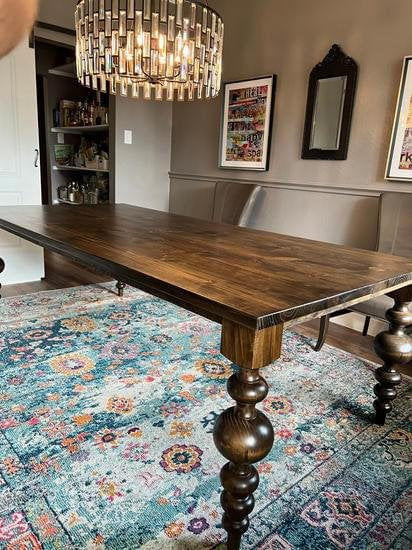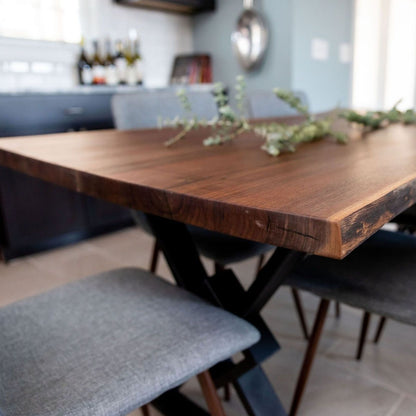How the Right Dining Room Table Legs Can Complete Your Dining Room Look
How the Right Dining Room Table Legs Can Complete Your Dining Room Look
Blog Article
From Typical to Modern: Locate the Suitable Dining-room Table Legs for Your Design
The option of dining area table legs plays a critical function in defining the overall personality of your area, bridging the void in between typical craftsmanship and modern visual appeals. While classic styles such as cabriole and turned legs stimulate a sense of ageless class, contemporary designs like barrette and geometric alternatives present a possibility for striking visual interest. Assessing the appropriate equilibrium in between these designs requires a nuanced understanding of your existing decoration and personal preference. As you consider these aspects, the inquiry continues to be: just how can you effortlessly integrate these diverse leg styles to develop an unified dining experience?
Recognizing Table Leg Styles
The range of dining area table leg designs can substantially influence both the looks and capability of the area. Each leg design contributes special sensible attributes and visual components, accommodating diverse layout choices and usage demands. Recognizing these designs is essential for selecting the right table that straightens with your general indoor style vision.
As an example, tapered legs provide a tidy, traditional look that can enhance a room's elegance, while pedestal bases supply security and optimize legroom, making them ideal for smaller areas. Barrette legs, a hallmark of mid-century modern style, present a commercial panache, enabling a ventilated, open feel. Similarly, trestle legs evoke rustic charm, offering robust assistance and a sense of timelessness.
Wooden legs can bring heat and appearance, whereas metal choices often convey a sleek, contemporary ambiance. Ultimately, recognizing table leg styles is necessary for creating a natural dining location that mirrors personal design while making sure practicality and convenience.
Conventional Table Leg Options
When selecting eating space table legs, conventional alternatives typically symbolize timeless style and workmanship. These designs reflect an abundant heritage and a commitment to high quality, making them perfect for those that appreciate timeless aesthetics.
One of the most famous traditional leg designs is the cabriole leg, defined by its elegant curved form. This layout usually features ornamental makings and is most commonly discovered in Queen Anne and Chippendale furnishings. One more popular choice is the transformed leg, which flaunts a series of smooth, rounded forms that provide a classic look while preserving security.
In addition, the straight leg, while simple, provides a durable and unadorned structure that can mix perfectly with a range of tabletop styles. For those attracted to ornate describing, claw-and-ball feet legs stimulate a sense of splendour and can act as a sensational focal point in any dining room.
Finally, stand bases, although not purely legs, offer an alternative typical alternative that enables sufficient legroom and can be perfectly carved. Each of these typical leg designs adds to the general setting of a dining-room, marrying function with aesthetic appeal.

Modern Table Leg Designs
Modern table leg designs provide a varied series of styles that stress tidy lines and innovative products. These styles hop over to here typically prioritize performance while functioning as striking prime focus within an eating area. Minimal visual appeals prevail, with legs crafted from products such as metal, glass, and crafted wood, which add to a airy and modern feel.
One popular style is the barrette leg, defined by its slim, tapered structure that offers security without overwhelming the table top (dining room table legs). This design is typically found in mid-century contemporary furniture and can easily match various dining table shapes. Another fad is making use of geometric forms, where legs might handle asymmetrical or angular forms, adding visual rate of interest and a touch of virtuosity

Blending Designs for Unique Areas
Commonly, home owners seek to produce one-of-a-kind eating spaces that reflect their individual style by blending various design aspects. This approach permits the consolidation of diverse aesthetic appeals, causing a harmonious yet unique setting. Matching a rustic wooden table with smooth, contemporary metal legs can create an eye-catching comparison that elevates the area's general allure.
In addition, incorporating vintage table legs with modern table tops can evoke a feeling of background while preserving a modern-day sensibility. Such mixes not only display private taste but also motivate creativity, permitting home owners to curate a room that really feels both personal and inviting.
Color plays an essential duty in this mixing procedure; picking table legs that match or comparison with the existing shade system can improve visual rate of interest. For example, whitewashed legs can soften the boldness of a dark table surface area, developing a balanced aesthetic.
Tips for Picking the Right Legs
Choosing the right table legs is vital for achieving both functionality and visual allure in your dining space. Begin by thinking about the total style of your area. Traditional setups take advantage of legs that include intricate carvings or turned designs, while modern spaces might require smooth, minimalist designs.
Following, examine the height and stability of the legs. dining room table legs. Conventional eating tables range in between 28 to 30 inches in height, so ensure the legs enhance this dimension for comfort. Additionally, robust materials, such as wood or metal, can boost security and durability
Evaluate the leg form as well-- options consist of straight, tapered, or pedestal styles. Straight legs offer a click to read more classic appearance, while tapered legs can add a touch of elegance. Pedestal bases supply enough legroom and are perfect for smaller areas.
Conclusion
In summary, picking the excellent eating space table legs calls for mindful factor to consider of both standard and modern designs. Standard alternatives such as cabriole and transformed legs provide classic elegance, while modern layouts like hairpin and geometric forms provide a modern touch. By integrating leg design, height, and material with the total decoration, a cohesive and inviting environment can be achieved. Inevitably, the chosen table legs need to mirror the desired aesthetic, boosting the dining experience within the area.
The variety of eating area table leg styles can substantially influence both the aesthetics and capability of the room. Inevitably, comprehending table leg styles is important for producing a cohesive dining area that shows individual style while making certain functionality and comfort.One of the most famous typical leg designs is the cabriole leg, defined by its stylish rounded shape. Straight legs offer a classic appearance, while tapered legs can add a touch of sophistication.In recap, choosing the suitable eating area table legs requires careful factor to consider of both standard and modern designs.
Report this page